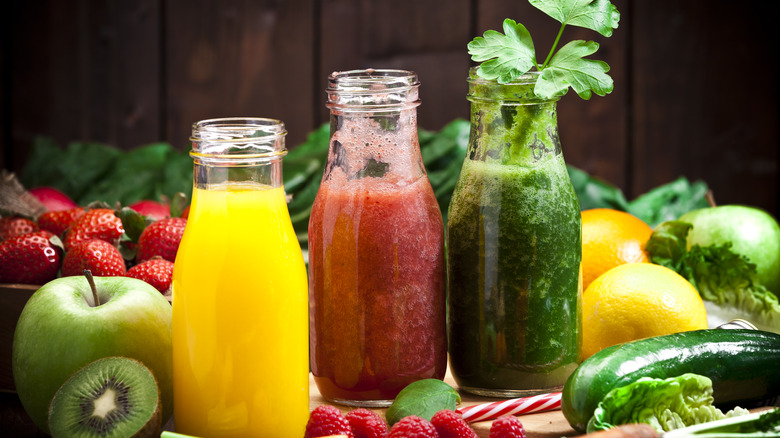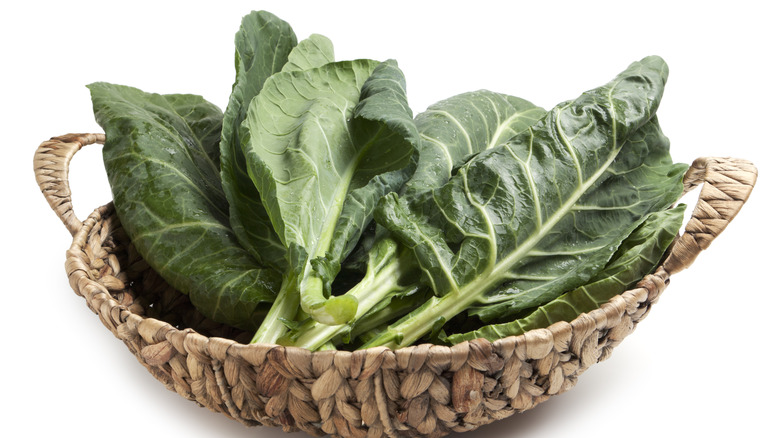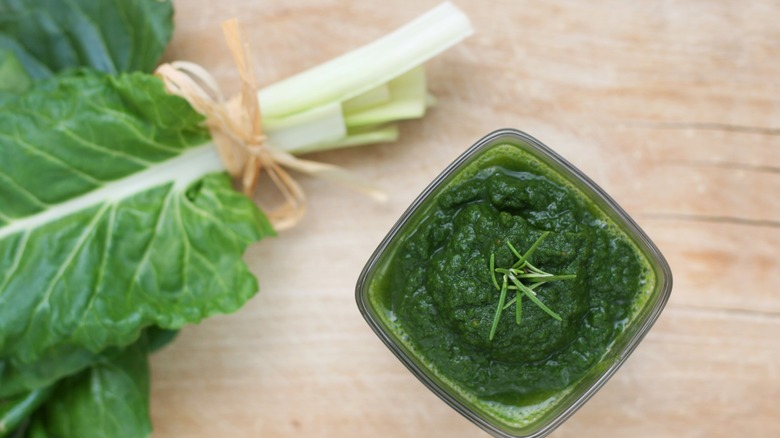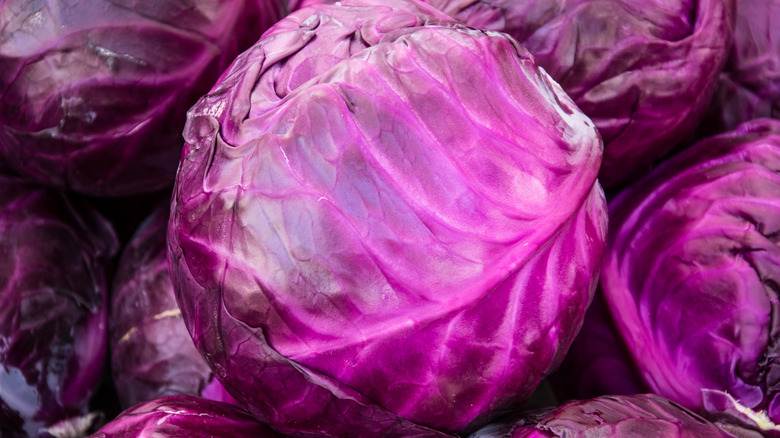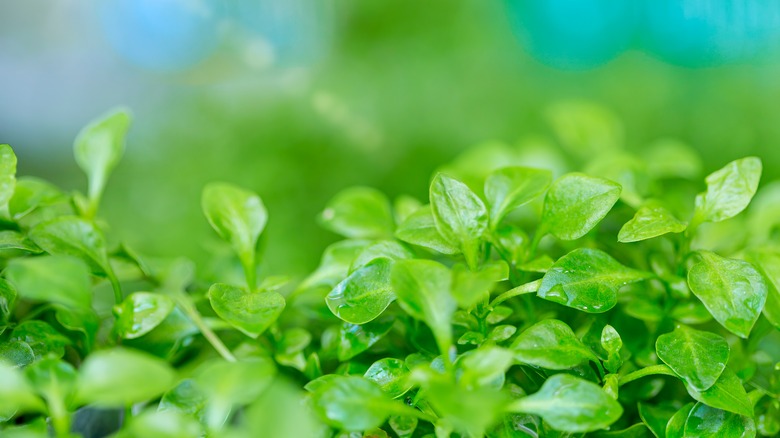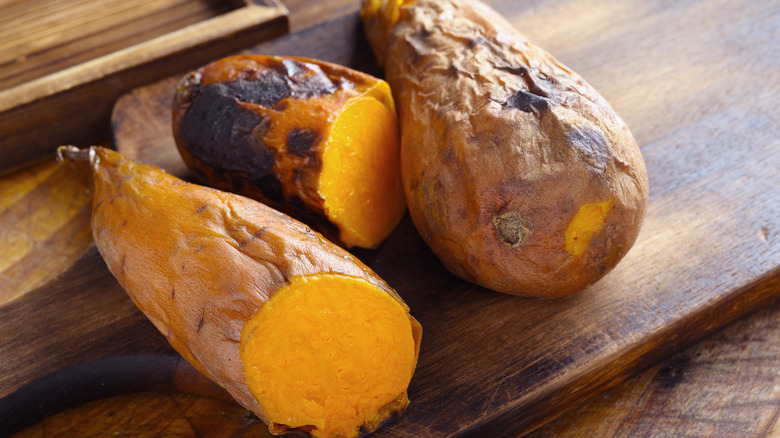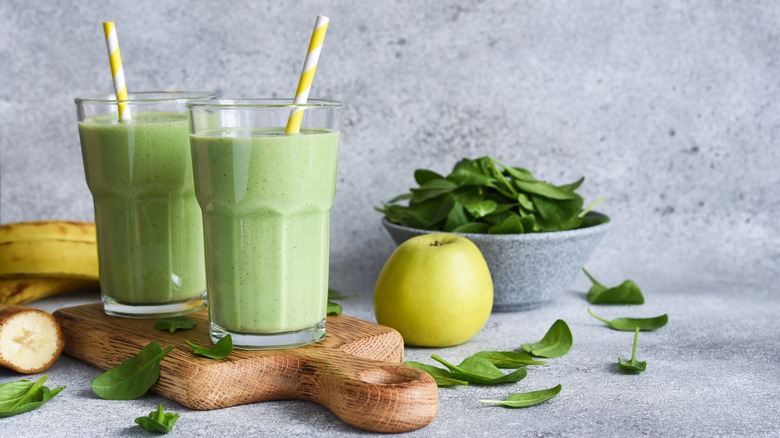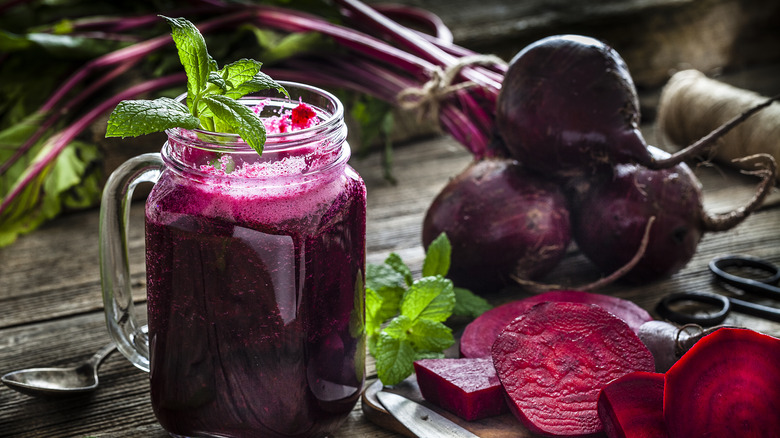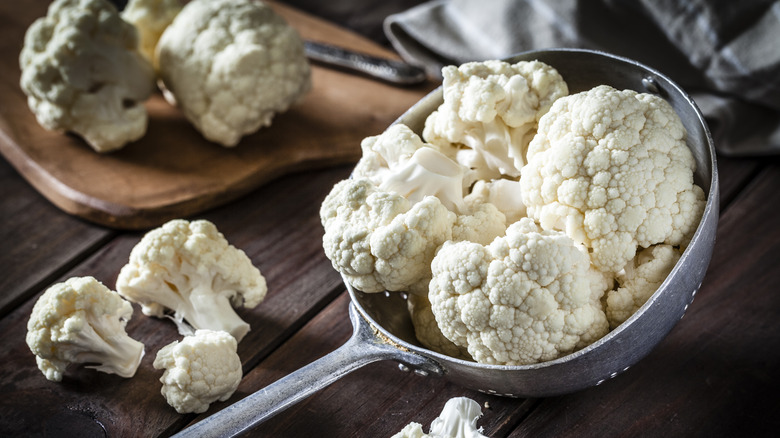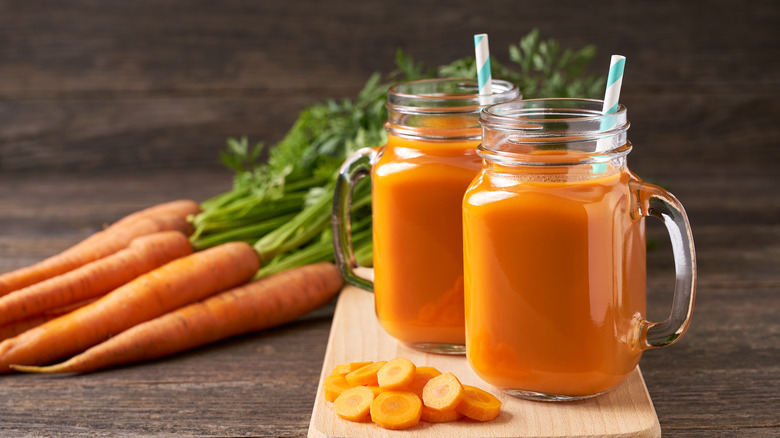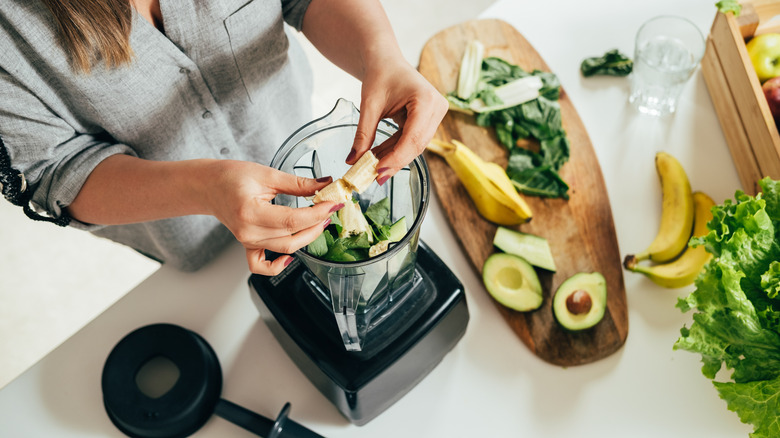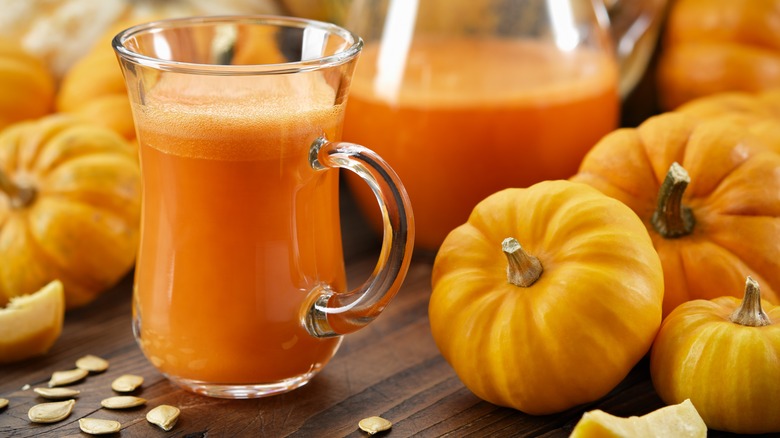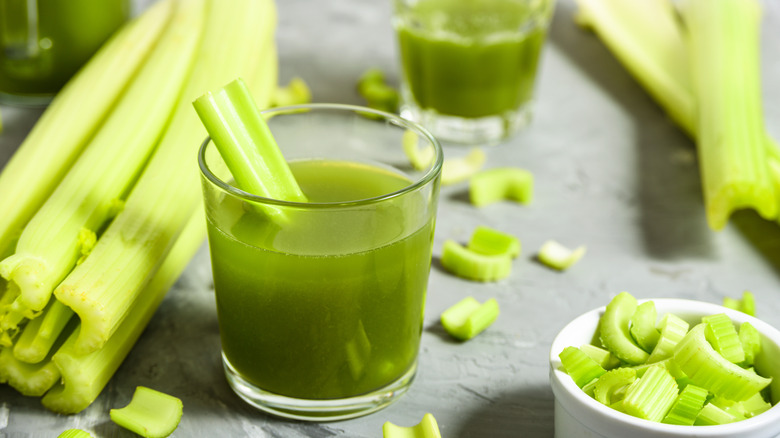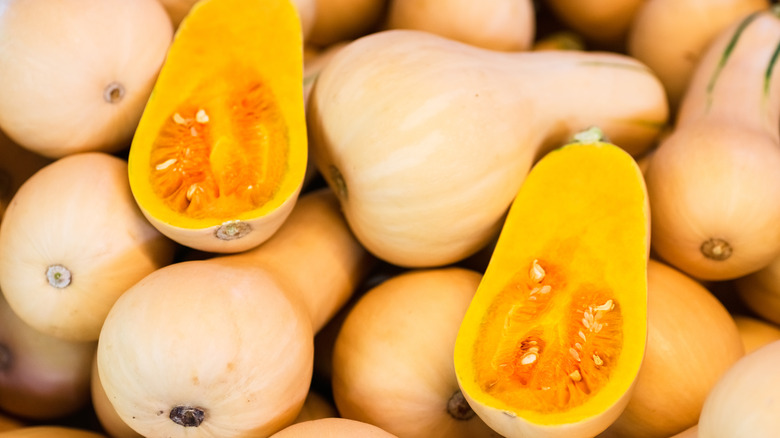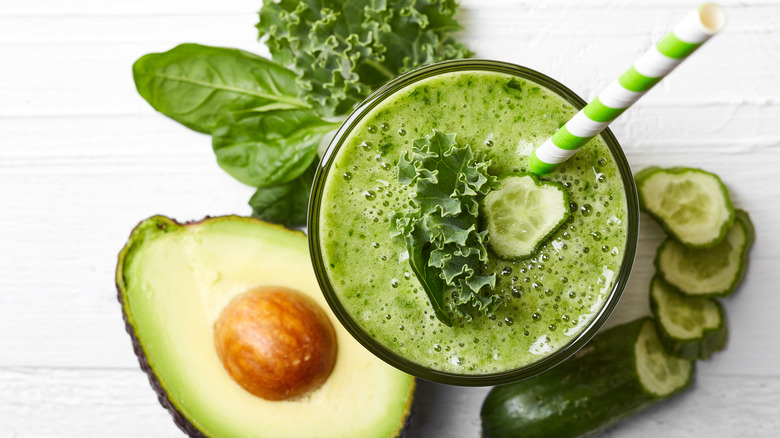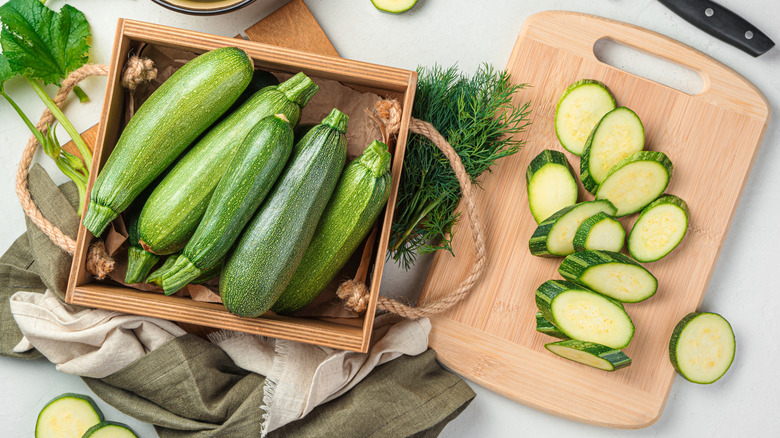15 Interesting Vegetables You Should Be Adding To Your Daily Smoothie
Sipping on a nice and cold smoothie can be a great way to start the day. Not only are these beverages refreshing, but they also deliver several nutrients from the different fruits and vegetables you add to them. If you've been making smoothies for a while now, you may be finding yourself in a bit of a rut. While your go-to recipe may taste great, if you drink it too many days in a row, you're going to get tired of the same flavors.
Finding a bit of inspiration may be all you need to make things interesting once again. And, when you change things up by adding some of the veggies listed below, not only will you benefit from new and exciting flavors, but you'll also be giving your body a healthy dose of various vitamins and minerals. From spinach to pumpkin and everything in between, let's take a look at some of the most interesting, tasty, and healthy vegetables you'll want to start adding to your daily smoothie. Which one will you try first?
Collard greens
Depending on where you live, you may be more or less familiar with using collard greens in the kitchen. They're a versatile leafy green that goes well with meats, beans, and even smoothies. An innovative alternative to the popular spinach or kale base, collard greens are a hearty ingredient that will keep you fuller for longer. Plus, collard greens contain more calcium, iron, fiber, and protein than kale.
This leafy green can be bitter on its own, but goes great with the added sugar of common fruits you would include in your typical smoothie. Try adding some collard greens with banana, berries, or mango for a down-south twist on a healthy breakfast. If you're feeling more Californian, add half of an avocado as well for a creamier and even more hearty green smoothie.
Like kale, you'll have to remove the edible leaves from their thick stems before blending. Just take a sharp knife and cut closely to the stem, removing the leaves before chopping them into smaller bits. Once blended, the leaves of collard greens develop an even richer bright green coloring than spinach or kale for a truly beautiful-looking smoothie.
Swiss Chard
Another leafy green, and a great substitution for collard greens, Swiss chard comes in a variety of different species with slight differences to their tastes and nutrients. The good news is that no matter what kind of chard you choose — lucullus, rainbow chard, rhubarb chard — you can't go wrong.
All varieties of chard are considered super greens and have tremendous health benefits, especially when eaten raw. Just one cup of raw chard contains more than four times the amount of vitamin K suggested for your daily diet.
Unlike collard greens, which are typically cooked before eaten, Swiss chards are usually eaten fresh as part of salads or soups. That makes this veggie a natural choice for a hearty, flavor-rich smoothie base. They're slightly less bitter than collard greens, but your smoothie is still best prepared with some sweeter fruits. Try mixing chard with more hydrated fruits like pineapple or berries as they can be rather thick on their own.
Purple cabbage
Purple (or red) cabbage is a fun one. While not as nutrient-dense as collard greens or Swiss chard, these colorful cabbages certainly are more vibrant.
Maybe you have a child who is a picky eater, or maybe you just can't touch another green smoothie ever again. Either way, purple cabbage is a great way to get your greens without actually eating green.
A medium-sized shredded head of cabbage will make roughly 8 ½ cups which should make eight or nine smoothies, be sure to refrigerate it in an airtight container. Take a few of your shredded leaves and throw them into a blender with other blue or purple fruits like blueberries, raspberries, or figs. They blend beautifully with bananas as well. The result will be a delicious blue smoothie that even the pickiest eaters will want to wash down.
And, just because these cabbages aren't as nutrient-dense as their leafier cousins, it doesn't mean that they're without health benefits. Purple cabbage contains more than 4 times more antioxidants than green cabbage varieties and has more nutrients than many other foods. For example, 100 grams of red cabbage has 57 milligrams of vitamin C compared to a carrot's 5.9 milligrams, according to the USDA.
Watercress
A little watercress goes a long way. Though the small herb-like veggie doesn't look very imposing itself, it packs a distinct taste that will cut through most other flavor profiles. If you're bored with your typical smoothies, watercress is one of the quickest and easiest ways to spice things up.
One of the oldest green vegetables ever recorded to have been consumed by humans, watercress has stuck around as a part of our diets for good reasons. Besides its stand-out, almost spicy flavor profile, the tiny greens are a part of the same family as Brussels sprouts, kale, and cabbage. They're packed with similar nutrients to their larger counterparts, too.
When harvested early enough watercress leaves will be packed with nutrients and therefore be considered a microgreen. And, their small size and big flavor make them an easy additive to any smoothie. Throw a little less than a handful on top right before blending with banana, melon, or Greek yogurt. As they have a little bit of a kick, try mixing watercress with more subtle flavors.
Sweet potatoes
You may think of sweet potatoes as the perfect side to a roast, but they can also make a wonderful addition to a smoothie. If you think about the texture of a cooked sweet potato, it should become clear why sweet potatoes can be such a great choice. They're so creamy, so when you mix them in with all of the other ingredients in your smoothie, it will make it nice and smooth. Before adding sweet potatoes to a smoothie, you'll want to cook them. Simply roast your potatoes in the oven for an hour or two or peel and boil them until soft. Then, let them cool and add them to your blender with the other fruits and veggies you want to mix together.
Beyond the creamy and delicious texture sweet potatoes will add to your smoothie, they'll also deliver several important vitamins and minerals to make it an even healthier start to your day. Sweet potatoes are high in fiber, which can help aid with healthy digestion. Because of their high beta-carotene content, sweet potatoes may help promote eye health. Beta-carotene is also an antioxidant and may help decrease your risk of developing certain types of cancer. This superfood is also high in vitamin C and vitamin A.
Spinach
If you've been making green smoothies, then you might have already tried adding spinach into the mix. For those who haven't already tried this amazingly healthy veggie, now is the perfect time to start. If you're worried that the "green" taste of spinach will overpower the fruits and other ingredients in your smoothie, leaving it tasting bitter — don't be. Spinach is relatively bland and will hardly be noticeable when mixed with some sweeter ingredients. If you want the flavor to be sweeter and more subtle, opt for baby spinach instead. Simply grab a handful or two of spinach from the fridge and toss it in with your other smoothie ingredients, and you're good to go.
Adding spinach to your smoothies will be a very healthy choice. As WebMD explains, it has a high potassium content and can support healthier blood pressure, while the lutein it contains can help protect against cataracts, macular degeneration, and other eye-related diseases. Additionally, spinach contains high levels of iron, an important nutrient the body uses to make hemoglobin. Hemoglobin is important for supporting the body as oxygen travels from the lungs to other areas. You'll also be happy to hear that spinach can help you meet the recommended daily amounts of vitamin A and vitamin K.
Beets
Beets in a smoothie? Don't knock it until you've tried it. Beets are naturally sweet, which makes them a natural choice for a blended treat. The beets will also help add some creaminess to the smoothie. You can reap the benefits of beets in your smoothie by adding them raw or by cooking them first. Cooking them first will make them more tender and easier to blend, but you'll want to make sure that you give them time to chill before mixing them in. If you want to skip this extra step, you can also add raw beets to the blender. However, because they'll be harder, you'll want to cut them into smaller chunks first to help ensure that they'll blend properly.
Healthline notes that beets offer a myriad of benefits, which you can start to enjoy when you add them to your morning blend. Consumption of beets has been associated with lowering one's blood pressure — particularly raw beets. Moreover, the betalains, or pigments, in the beets can help with chronic inflammation and osteoarthritis, and other inflammatory issues. A few of the other benefits of beets include their high fiber content to aid with digestion and their higher level of nitrates, which can support healthier brain functions.
Cauliflower
When you're thinking about vegetables to add to a smoothie, chances are that cauliflower wasn't one of the first ideas that popped into your head. However, once you learn more about how it can enhance your smoothie, we think it will be one that you'll want to try. As with many other veggies, you can either add the cauliflower raw or steam it first to soften it up. Steamed cauliflower may blend a bit easier and add an extra hint of creaminess, but raw should break up just fine in the blender, too. Cauliflower has a more neutral taste as well, so don't worry about it overpowering the other ingredients in the smoothie.
The biggest reason you might want to start adding cauliflower to your smoothies, however, is the health benefits it will bring with it. As The Mayo Clinic explains, it is a fat-free, low-sodium, and cholesterol-free food and is very good for you. What's more, it's also high in folate to support the growth of new cells in the body. Cauliflower also contains higher levels of vitamins C and K to support your body.
Carrots
A yummy carrot smoothie can help you get your day off to a great start. While you can incorporate carrots into any of your favorite smoothie recipes, you might find that it tastes particularly good with apples. Carrots and apples are in season at the same time of year, so you could even go and pick them fresh before adding them to a smoothie. Raw carrots are easy for your body to digest. However, because of how hard this veggie is, you might find that cooking them first will be the better option for your taste buds and your blender. Plus, when cooked, they will help to smooth out the smoothie and make it a bit creamier.
Health explains several benefits of carrots. As a child, you were likely told to eat carrots to help your eyes. This was good advice then, and it is still good advice today, as carrots are high in vitamin A (you can reach the daily recommended serving by eating just one cup of carrots. Carrots are 88% water, helping them to make you feel more satisfied after a meal. A few other carrot benefits include supporting a healthy immune system, helping your body better regulate its blood pressure, and supporting a healthy brain.
Avocado
The smooth and creamy texture of an avocado makes it a great choice when you're looking for something new and exciting to add to a healthy smoothie. Instead of the icier taste that many green smoothies can have, you'll be thinking that you're sipping on a milkshake instead. Plus, avocado can be very filling, so adding it to the drink is an excellent way to make sure you feel satisfied and aren't looking to snack as much. You can add avocado with any other ingredients, but it can taste exceptionally good with berries, apples, or bananas.
Adding avocados to your diet can help support a healthy heart, according to MedicalNewsToday. This is because they are high beta sitosterol, a plant sterol, that can help keep cholesterol levels under control. What's more, avocados are also high in zeaxanthin and lutein, which can support healthy vision. This superfood is also high in folate, which is good for reducing the risk of depression and supporting fetal development in pregnant women. Avocados are also high in vitamins B6, C, E, and K, magnesium, potassium, niacin, and more.
Pumpkin
If you're looking for the perfect smoothie ingredient to get you ready for the crisp and cool fall weather, you'll want to try some pumpkin purée (it's easy as it comes without pumpkin seeds). Get your day going with your version of a pumpkin pie in your cup without all of the unnecessary calories. Add pumpkin purée to any smoothie recipe if you want to make it a little extra creamy, but we think you'll like the way it tastes with bananas and some pumpkin pie spices. Pumpkin may technically be a fruit, but like squash, it can masquerade as a vegetable.
OSF HealthCare explains that there are several reasons to add more pumpkins to your diet. The fruit is high in fiber, which can support healthy cholesterol and help you stay full for longer periods after finishing a meal. Pumpkin is also an excellent source of beta-carotene (think about the deep orange color). Beta-carotene is converted into vitamin A by our bodies, which means that eating pumpkins can help support a healthy immune system and healthy eyes. You'll also get a good potassium dose with each pumpkin serving. Potassium can aid our body in regulating blood pressure and supporting bone health.
Celery
Celery is another superfood you might want to add to your blender the next time you make a smoothie. If you've eaten raw celery before, then you know that it has a stronger taste, and you might be questioning whether it really is the right fit for a smoothie. However, with the right mix of other ingredients — banana and apple offer a wonderful complement and can help tone down the flavor — you'll be craving this addition in no time.
Plus, with all of the benefits Healthline shares celery has to offer, there really is no reason not to give it a try. First, celery is very low in calories, so you can add it to bulk up your smoothie without adding many calories into the mix. The veggie also offers a nice dose of antioxidants, such as flavonoids, vitamin C, and beta-carotene, to support healthy cells, organs, and blood vessels. It can also aid with healthy digestion, work to prevent inflammation and help neutralize the more acidic foods you eat.
Butternut squash
Like its other orange 'friends,' pumpkin and sweet potato, butternut squash is a great choice when you're looking to make your smoothie smooth and creamy. The next time you cook a butternut squash, save your leftovers for a smoothie the next day. Whether you cooked the squash whole, cubed it, or roasted it with a special ingredient, you can toss it into your blender and reap the yummy benefits. If you don't have any leftover butternut squash but can't wait to try this recipe idea, pick up a can or frozen bag of it from the grocery store.
So, why else will you want to add butternut squash to your smoothie? Well, if the creaminess factor isn't enough for you, then you'll be pleased to hear that the winter squash is high in potassium, which can support healthy blood pressure. Butternut is also high in beta-carotene, which MedicalNewsToday says may help lower one's risk of asthma. Moreover, butternut squash is high in fiber, vitamin A, and vitamin C. There are so many reasons you should try it in the next smoothie you prepare.
Cucumber
If you've ever sipped on cucumber-infused water, you know how refreshing it can be. Why not try to recreate that same effect with your next blended treat? Just coarsely chop up about one-third to one-half of a cucumber and add it to the blender. You can toss it in with any ingredients you'd like, but if you want to keep that refreshing taste, try it with some frozen pineapple and coconut milk. Consider also adding in some of your favorite leafy greens, such as spinach or chard.
You typically see them on salads, so you probably already know that cucumbers are good for you. But do you know what makes them so healthy? Well, as The Cleveland Clinic explains, the high water content of a cucumber allows them to help keep you more hydrated, which can support digestion, kidney function, and much more. What's more, this fruit (yes, cucumbers are technically not a vegetable) can also help keep your bones healthy thanks to the high dose of vitamin K they deliver. If you still need more reasons to try cucumber in your smoothies, they are also high in fiber to support digestion, contain lots of potassium to help reduce blood pressure, and can support a healthy weight by making you feel fuller longer because of their higher water content.
Zucchini
From zoodles to roasted zucchini to bread, zucchini seems to be everywhere these days. So, why not try it in your smoothie too? When you add zucchini to a smoothie, it can help ensure that the finished drink will be nice and creamy. If you typically add bananas for this reason, change things up a bit and try zucchini sometimes instead. Unlike bananas, which are high in sugar, zucchini will help keep the overall sugar content of the beverage down.
According to WebMD, the lower sugar content isn't the only reason to consider adding zucchini to your smoothies. Because it is high in vitamin B6, zucchini may be able to help individuals regulate their blood glucose levels. Like some of the other veggies on this list, zucchini can also support healthier eyes thanks to the lutein and zeaxanthin it delivers to your body. As a low-fat food, adding zucchini won't do much to increase the caloric content of your smoothies, either. There are only 55 calories and 1 gram of fat in each large zucchini.
